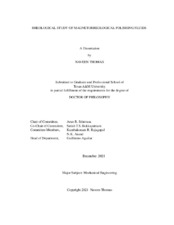| dc.description.abstract | The aim of this work is to study the flow behavior of magnetorheological polishing fluids/ slurries, with specific focus on answering the following two research questions: a) What is the suitable model for a polishing slurry in the absence of magnetic fields? And how to select a model from among a class of possible models in an objective manner?, b) What causes segregation and brush formation in MR polishing fluids in the presence of magnetic fields? and how does shearing affect the segregated structure?
In the first half of the work, an experimental study was conducted to find appropriate models for polishing slurries. In the later half of the work, a mixture theory based model was used for the segregation and rheological behavior of the magnetorheological (MR) polishing mixture. Then numerical studies are conducted to study the segregation behavior of the mixture under stationary and couette type bulk flow conditions in the presence of magnetic fields.
In the work for identifying rheological models for polishing fluids, a novel means for obtaining rheological properties of polishing slurries for a given class of models by combining CFD and measurements of Torque vs Speed Data is discussed. Experiments were conducted using a custom-built torsional rheometer that subjects the polishing fluid to conditions that are similar to polishing. Comparison with the analytical solution indicates that side wall and inertial effects (ignored in the analytical solution) significantly affect the values of the parameters of any given model even under nominally slow rates of rotation. This significantly affects model selection as described below.
Using statistical inference techniques (the Akaike Information Criterion), among the three rheological models, namely the Bingham fluid model, the Power-law model and the Herschel-Bulkley model, considered for the fluid, the Herschel-Bulkley model seems to be a significantly better fit compared to other models for the slurry. The results suggest that a systematic combination of computational-statistical-data science approach is necessary for identifying model parameters even for slow flows as compared to currently used data reduction methods based on analytical solutions for torsional flow that ignore inertial and side-wall effects.
Segregation and flow behavior of the MR polishing mixture is modeled using mixture theory. The dipole-current circuit approach was used to model the magnetic behavior of the polishing fluid. Balance equations for the bulk mixture fluid and the relative flow of the magnetic component are derived. Thermodynamically consistent constitutive models were developed for the fluid to exhibit segregation through diffusion and flow of the bulk mixture during the polishing process. A mixture model for the bulk flow velocity, formulated using the volume concentrations of the component as weights, is observed to enforce the incompressibilty constraint directly on the bulk velocity. Thus, this approach can easily accommodate the simple incompressible models used to experimentally characterize the mixture.
A polishing mixture with a magnetic component concentration of 50 % is considered in simulations. Decoupled and coupled simulations of stationary mixture under different magnetic field boundary conditions were performed. The results showed that coupling the magnetic field equations with the convection-diffusion equations is necessary to capture the segregation and formation of brushes in the mixture. A non-dimensionalized study of simulations of a perturbed stationary fluid identifies that the segregation behavior of the mixture depends upon the magnetic coefficient and the initial brush width of the perturbation in the fluid.
Evolution of the magnetic component’s concentration in a segregated fluid while undergoing a couette type flow in the presence of uniform magnetic field is simulated. It is observed that, at low shear rates, the mixture is able to segregate periodically as the brushes are reformed after breaking. But, at higher shear rates, the segregated mixture mixes completely. | |


